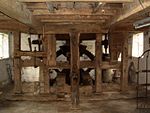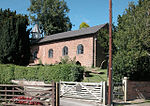Bridge Trafford

Bridge Trafford is a hamlet and former civil parish, now in the parish of Mickle Trafford and District, situated near to Chester, in the unitary authority of Cheshire West and Chester and ceremonial county of Cheshire, England. The hamlet lies some 2 miles (3 km) to the north of the centre of the village of Mickle Trafford on the A56 road (grid reference SJ450713). At the 2001 census it had a population of 33. The civil parish was abolished in 2015 to form Mickle Trafford and District.It is believed that the Roman road from Chester to Wilderspool (now part of Warrington) passed through the parish. In 1991 a Roman bronze brooch was found in the parish.Immediately to the south of the hamlet the River Gowy is crossed by Trafford Bridge. A stone bridge was first built here in 1410 and there was probably a wooden bridge before that. After the Civil War the bridge needed repairs and these were carried out in 1648.
Excerpt from the Wikipedia article Bridge Trafford (License: CC BY-SA 3.0, Authors, Images).Bridge Trafford
Warrington Road, Chester Mickle Trafford and District
Geographical coordinates (GPS) Address Nearby Places Show on map
Geographical coordinates (GPS)
| Latitude | Longitude |
|---|---|
| N 53.235 ° | E -2.825 ° |
Address
Warrington Road
CH2 4JR Chester, Mickle Trafford and District
England, United Kingdom
Open on Google Maps









